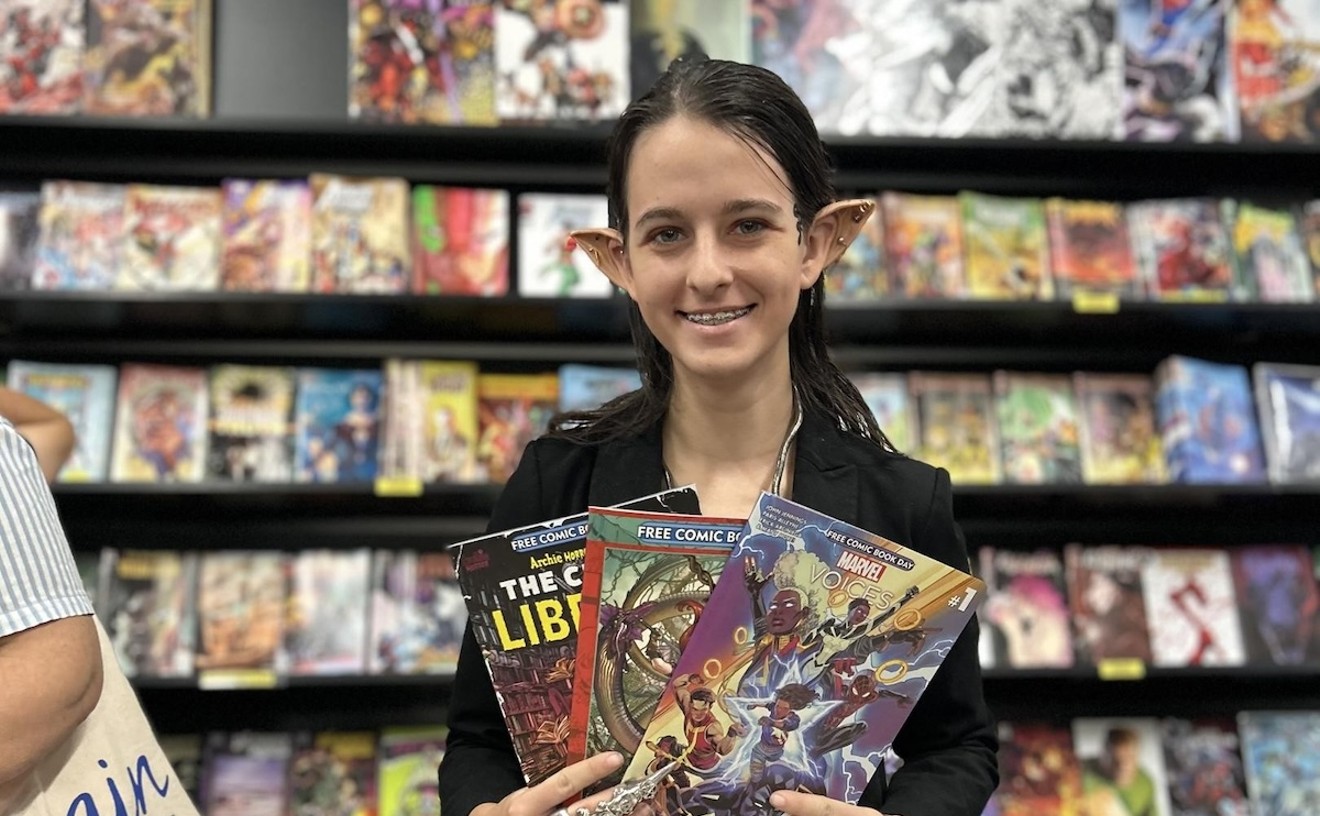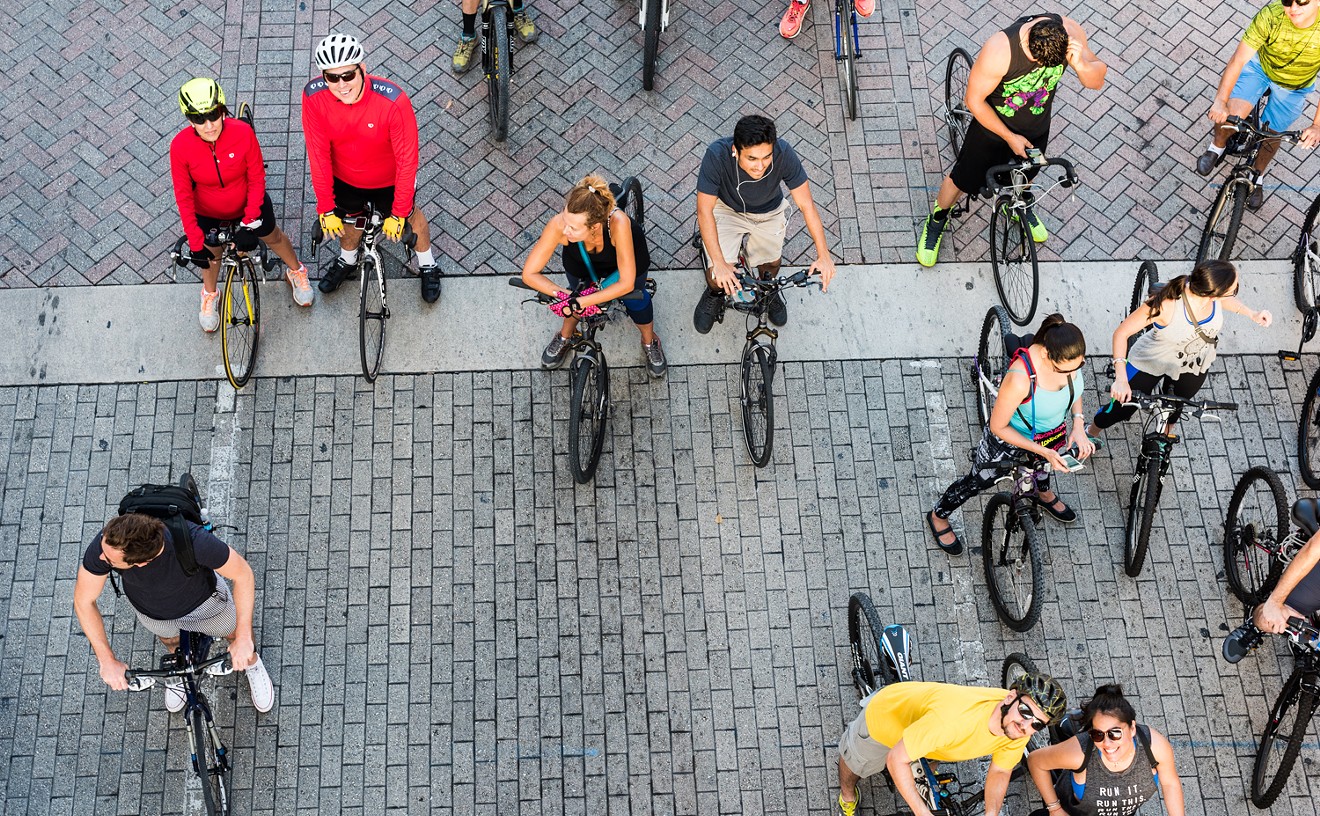With his Mack truck-size opus on view at the Frost Art Museum, Yao Jui-cheng transports the spectator to the vertex where old Taiwan intersects with the new.
Heaven, Yao's sprawling photo and mixed-media installation, swallows most of the museum's center gallery and appears somewhat like an alky-cooking operation from imperial times.
On the wall are 15 large black-and-white images treated with gold leaf and encased in ornate hand-carved gold frames that recall the opulence of the past and the consumptive power of the present.
The striking conglomeration of images includes mammoth mutant crabs, Mandarin emperors, a reclining Buddha, grappling dinosaurs, a giant pyramid, a fire-breathing dragon, animal topiaries, a Godzilla-like creature, and a kowtowing baby with a sonic boom erupting from its ass.
From these disparate pictures snakes a cat's cradle of shiny half-inch copper tubing in a soaring sculptural mass attached to what looks oddly like an old-fangled brass diving helmet hanging from the rafters. It floats at eye level and houses a small video monitor. Viewers are invited to slip their heads into the bizarre contraption, where the senses get sucked into a loopy, electromagnetic realm that resembles a wormhole.
It's part of the artist's efforts to liberate the senses from illusion and desire in an increasingly complex world. Each image sends out a strand of the copper tubing, and at the center of Yao's weird energy field of pictures lies the baby, his tailbone connected directly to the front of the helmet, suggesting that insidious external influences begin contaminating our brains immediately after birth. With a bold sense of irony and wit, his work subverts and challenges traditional notions of cultural identity and deeply rooted ideologies.
Yao's majestic installation is part of "Taiwan Discovered: In Place and Time," an intriguing exhibit featuring seven contemporary Taiwanese artists in the first show of its kind in the Southeastern United States. Works on display range from video, sculpture, painting, multimedia installations, and rock art. It's part of the Frost's continued foray into Asian art and was curated by museum director Carol Damian and Catalina Jaramillo.
Near the gallery's entrance, visitors are immediately struck by the participants' wildly diverse approach to making art.
Long-Bin Chen deploys discarded books and texts to create sculptural gems that might make you stop and stare. His Guan Ying (Computer/Psychology), fashioned from computer manuals and psychology textbooks, evokes the spirit of the Chinese goddess of compassion and appears to have been chiseled out of stone. Likewise, India Buddha Boston gives the impression it could have been discovered at an ancient temple rather than carved from a stack of Beantown phone books.
His works speak to the power of knowledge and the written word. They also refer to how books are becoming increasingly obsolete in the Internet age. By using recycled materials, the artist also offers a commentary on the consumption of natural resources and rampant human waste.
Another artist who uses recycled materials is Huang Pei-ying. Her wall sculpture, Spreading, employs glued cardboard accretions that are peeled back layer by layer to reveal biomorphic, corrugated patterns resembling knotted forest tree trunks covered in spores or an alien life form hijacked from a 1960s B movie.
True to the work's title, the quixotic forms stretch across the wall like a fungal growth and at their center contain mirrors refracting the viewer's image, suggesting humanity's mindless destruction of ecology.
Among the more unusual works on display are Tsung-chen Chang's impressionistic depictions of sweeping vistas of valleys, rivers, and mountains. They are painstakingly created using translucent slivers of rocks that seem to have been put through a meat slicer to confect dazzling images of impeccable craftsmanship and inherent beauty.
With poetic titles such as Spring Willow Creek, Country Cottage and Cloudy Sky, and Misty Forest and Mountain in Spring, his works carved from nephrite, quartz, or rhodonite shimmer with brilliant multihued natural tones that conjure a primordial nature seen through the sheer gauze of memory.
Photographer Chao-pang Hsu also evokes notions of geological formations in colorful works reminiscent of Google Maps' bird's-eye views of sea shores and mountain ranges. But his images fail to radiate the same subtlety and range of Tsung-chen's work and suffer by comparison.
An artist who also tinkers with Taiwan's enduring tradition of landscape painting is Kay H. Lin, whose labor-intensive canvases resemble lush ancient scrolls.
She applies layer after layer of jewel-hued paint to create a sense of sedimentary thickness. Then she sands the canvasses' surfaces to reveal vibrant blossom bursts of undercoats that shimmer and add a deeply textured richness to her abstract paintings.
Endless No. 8 radiates with succulent cherry, pink, and plum tones, and Endless No. 7 glows with emerald, moss green, and baby blue. The effect is more akin to an embroidered tapestry than a traditional painting, reflecting humanity's deep relationship with nature in a truly inspired and beguiling way.
Isolated at the rear of the museum, Tseng Yu-chin's ruminations on childhood strike a haunting chord. In I Hate Assumptions, a multichannel video projected on opposing walls, the artist captures a group of elementary school children riding a bus and nodding off with their mouths agape as if in the midst of a communal narcoleptic seizure. The hypnotic sound of chiming bells enhances the sense that the tykes are suffering in a trance-like state.
A museum handout informs that Tseng is interested in questioning the weakening power of tradition within the family and community in a rapidly changing Taiwan. His atmospheric film seems to also riff on social conditioning and awakening consciousness during a toddler's formative years in a strictly structured society.
At the Frost, this meditative and compelling show not only offers an opportunity to discover a group of artists rarely encountered in these climes, but also demonstrates the museum's commitment to continue showcasing the best of contemporary Asian art and its ascending role on the global stage.










